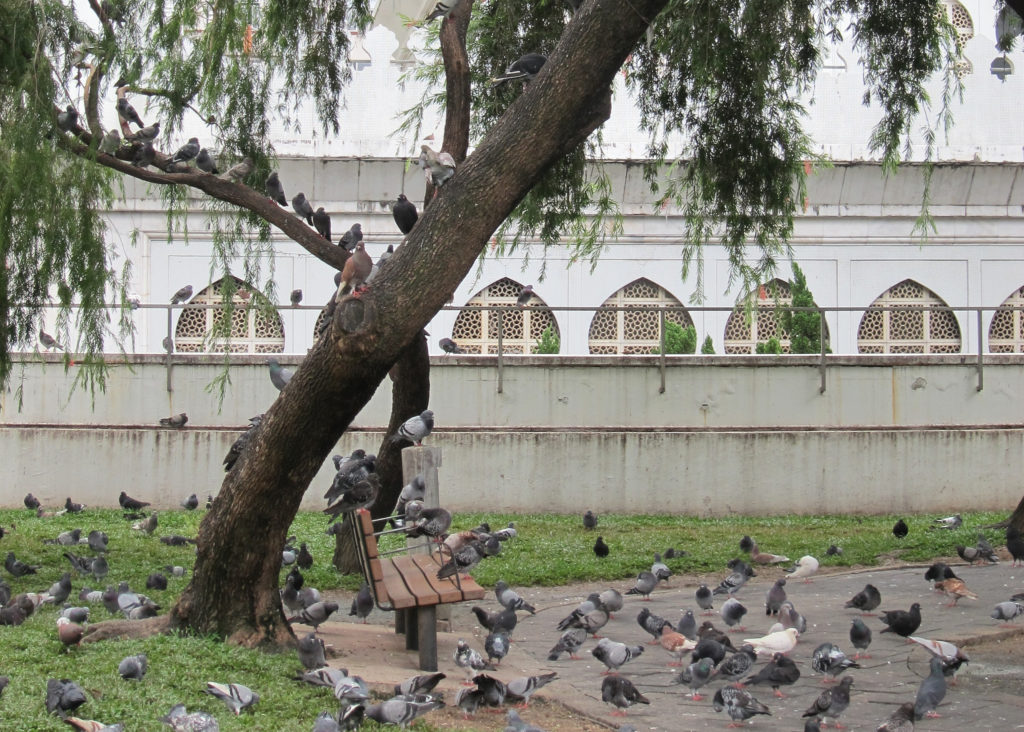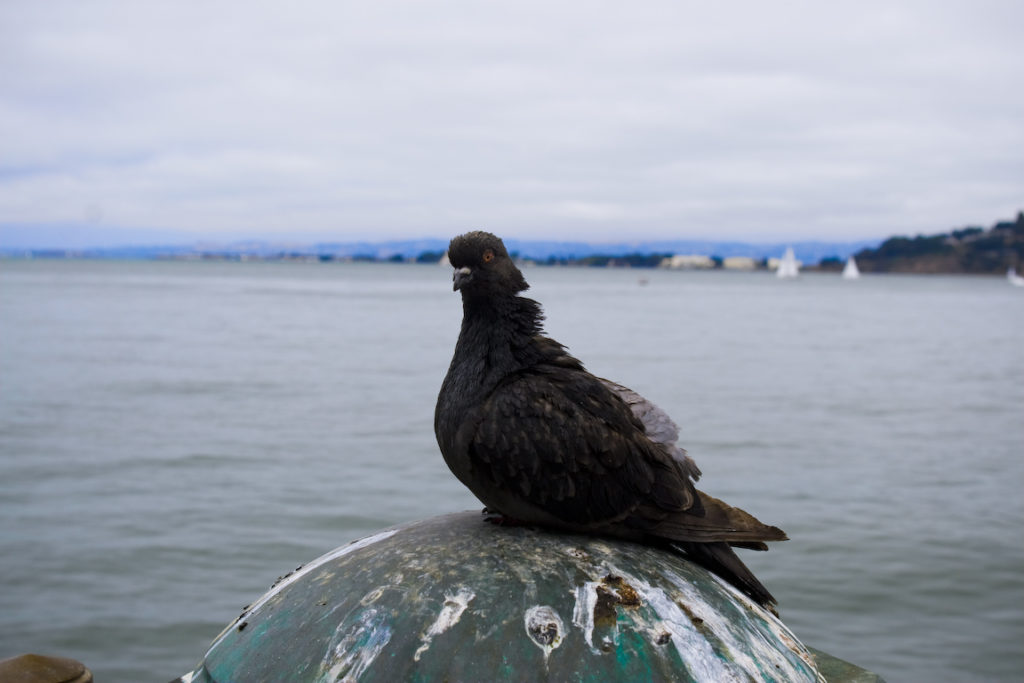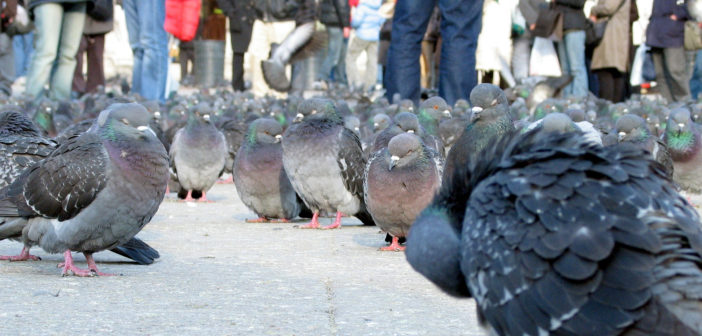Unlike Trafalgar square in London or the Piazza San Marco in Venice, where they are a tourist attraction, pigeons are considered a major pest problem in many urban areas. As with many animals who are considered pests, this raises a difficult question, especially for those who aim to treat animals humanely.
Feral pigeons descend from the rock doves that inhabited the rocky cliffs of Europe. These birds nest under ledges or in the sides of buildings. To some extent pigeons are found in nearly all urban areas and it is estimated that their population is growing parallel with increased urbanization and human populations.
Today pigeons are highly dependent on humans to provide them with food and sites for roosting and nesting. They are commonly found in areas or structures where they have access to food, water and shelter.

Pigeons in Hong Kong’s Kowloon Park. Because they reproduce rapidly and have few predators in most urban areas, populations can balloon quickly. Image credit snickclunk, CC BY-SA 3.0.
When Too Many is Too Much: What are the negative effects of large pigeon populations?
Aside from being perceived by many to be a general nuisance, pigeons have also been known to destroy property and spread disease. Given their reproduction rate and that they have no natural predators in most urban areas, if ignored, businesses and tourism industries stand to lose revenue due to the damage they cause.
Often, the issue is not the pigeons themselves but rather what they leave behind: debris, nesting material and worst of all, a mixture of urine and feces. A pigeon consumes roughly 30 grams of dry matter and 30 ml of water, daily. Do the math and a flock of just 100 pigeons can deposit up to 4,800 pounds of waste, annually. That represents a lot of poop and it has to accumulate someplace.
Pigeon droppings hasten the deterioration of buildings and increase the rate and cost of maintenance. Their feces produce a foul smell and can even kill vegetation. Pigeon manure in parks and on benches poses an aesthetic and sanitary problem to the unwary pedestrian or visitor. At hotels and especially outdoor restaurants, pigeons represent a chronic pest bird problem and a chronic source of complaints from both local residents and tourists.

A pigeon and the mess they leave behind. Image credit .imelda, CC BY-SA 3.0.
Can the problem be solved?
When the food supply is abundant, pigeons breed rapidly. Even with a short life span, pigeons can produce hundreds of related offspring in just 2 years. Controlling their population has now become a concern owing to the problems they present. This is further exacerbated by well-intended people who feel compelled to feed them.
In an attempt to combat their growing population, traps, poisons and nets have been employed at the ground level. Beyond being inhumane solutions, the results of these tactics are not long lasting and the effects are limited. With regard to long-term reduction, restriction of the food supply has been identified as an effective method of deterring feral pigeon populations, but this is relatively impractical in a large urban area.
Reproduction is the key
Conventional pigeon deterrents systems are largely inhumane and do not directly address the problem, because they only exclude birds from a particular area. Being mobile, the pigeons merely move to another location.
There is, however, another option: New contraceptive technology that has been shown to effectively reduce the pigeon population with no harmful side effects to people, pets or other animals, or the environment. The effect of the active ingredient (nicarbazin) is similar to human contraception given orally once a day, in this case via an automatic feeder. Since no new pigeons are replacing the old ones, the population declines through attrition at an average rate of 50% each year. This approach has been used to great success in various areas of Hawaii, and more recently was adopted to control pigeon populations at a SkyTrain station in Vancouver, British Columbia.
Avian contraception was noted as the most preferred method to control pigeons in a 2011 survey conducted by the Waikiki Business Improvement District and the University of Hawaii. Due to its non-lethal effects, it is also supported by animal welfare groups including The Humane Society of the United States. Bird birth control is the most effective way to address the feral pigeon problem, making urban centers not only a safe haven for tourists, but for animals and the environment as well.
Featured image: pigeons in Venice. Image credit John Leach, CC BY-SA 3.0.






3 Comments
Brilliant solution to a problem. There haven’t been pigeons welcomed in Trafalgar Square for decades for the record …
How about doing the same with for the monkeys who are decimating life on Earth, changing the climate, polluting everything and turning on each other on a regular basis?
I agree, the biggest pest problem on the planet are humans.
I have met and spoken with the owner of this company when he was visiting in Las Vegas. Some of our larger hotel/casinos have been using this method and it is by far more (permanently) successful and kinder than any other method of pigeon control. I would love to see it implemented worldwide, replacing so many of the other inherently cruel and ineffective methods of “pest control” that are currently being utilized.